Chapter 1
Action on climate change for a world free of poverty
Introduction
Climate change is written indelibly on the agendas of governments around the world. After years of incontrovertible evidence that the climate is changing – with increasingly frequent extreme weather events such as droughts, floods and heatwaves, along with slow-onset signs such as melting glaciers, and rising sea levels – finally a political ‘sea change’ has occurred in countries’ collective response to the challenge.
In 2015, representatives of 195 governments concluded the historic Paris climate agreement, stating that “climate change represents an urgent and potentially irreversible threat to human societies and the planet and thus requires the widest possible cooperation by all countries, and their participation in an effective and appropriate international response” and “acknowledging that climate change is a common concern of humankind.”
Until that moment, United Nations climate agreements had set a global target of limiting average global temperature rise to 2-degrees above pre-industrial times. This was based on the scientific understanding that beyond 2 degrees, the effects of climate change on ecosystems and related social, economic and political systems would become unmanageable. In Paris in December 2015, the mood shifted.
By the time of the Paris Summit, average global temperatures had already risen 0.85 degrees Celsius above pre-industrial levels. Greenhouse gas emissions worldwide were still rising – their rate of growth in the previous decade was the fastest ever. The year before, the Intergovernmental Panel on Climate Change, comprising hundreds of climate science experts and endorsed by the world’s governments, concluded that “it is extremely likely that human influence has been the cause of the observed warming since the mid 20th century”.
In Paris, the most climate-vulnerable nations – low lying island states and least developed countries – brought a powerful human dimension to the debate. They argued that if climate change impacts they are suffering at almost one degree of warming are so severe, then a 2-degree world would be unimaginable: some territories would simply cease to exist. Poet Kathy Jetñil-Kijiner of the Marshall Islands – whose government delegates emerged as leaders of the ‘High Ambition Coalition’ at the Paris Summit – said before the Summit: “Scientists and climate change specialists have been advocating that we need to lower our carbon emissions so that the world’s temperature doesn’t rise above 2 degrees or catastrophe of the worst kind will hit – think “super droughts, rising seas, mass extinctions. Why is 2 degrees even considered an option if that would mean low-lying atolls drowning? This is why our island leaders have been pushing for 1.5 … I’m going to Paris because I’m fighting for our home.”
Extreme droughts that were once unthinkable in the region are now more frequent, intense and unpredictable. They are exacerbated by climate change and by the fact that the forest can no longer respond to this phenomenon and regenerate itself in the same way it used to. Future scenarios are less optimistic: it is projected that if warming trends continue, Amazonia will suffer from severe droughts every other year by 2025.
Yolanda Kakabadse, WWF President and member of CDKN’s Network Council
As a result of tireless ‘climate diplomacy’ by the Marshallese and others, delegates reached a stronger, collective resolve, and finally agreed to (in the words of the Agreement) “holding the increase in global average temperature to well below 2ºC above pre-industrial levels and to pursue efforts to limit the temperature increase to 1.5ºC”.
The Paris Agreement also acknowledged that some climate change impacts may now be causing loss and damage to vulnerable societies. In other words, some impacts are already unmanageable and beyond the scope of climate change adaptation measures.
The reality of climate change today
Far from being a distant prospect, climate change is with us today, affecting our lives and our health.
Parts of eastern Africa are suffering more cases of malaria because of higher temperatures.Studies from South Asia have shown an association between diarrhoea outbreaks and a combination of higher temperatures and heavy rainfall. Scientists find that changing climate conditions in Latin America are increasing illness and death, and leading to outbreaks of diseases in new areas.
Climate change is altering the productivity of land and marine ecosystems on which societies depend for food and livelihood. It has already had negative effects on wheat and maize production in parts of Africa. The productivity of fisheries in the Great Lakes and Lake Kariba, and fruit-bearing trees in the Sahel have all decreased as a result of climate change, compounding food security problems.
Countries are losing land and coping with the aftermath: with rates of sea level rise at 3 mm per year, flooding and saltwater inundation in South Asia is already displacing people – permanently. Climate change poses a threat to the very existence of some small island developing states.

Climate is now a mainstream issue, with global goals for low-carbon, resilient societies
The groundwork was laid for the Paris Agreement by the Sustainable Development Goals (SDGs), which were agreed in September 2015 and are intended to be met by 2030. The SDGs are 17 broad-reaching goals, with 169 targets, covering vast areas of social and economic life and the health of the natural environment.
A dedicated goal (Goal 13) aims to “combat climate change and its impacts”. However, there are explicit targets for achieving climate resilience and reducing greenhouse gas emissions in seven of the SDGs, addressing energy, sustainable production and consumption, food security and human settlements. The apex first goal on “ending poverty in all its forms” includes a target to “reduce the exposure and vulnerability [of the poor] to climate-related extreme events” and other environmental and economic shocks. The energy-related targets address climate change directly, calling for a substantial increase in the share of renewable energy in the global energy mix and a doubling of the global rate of improvement in energy efficiency by 2030.

Source: https://sustainabledevelopment.un.org
The connection between climate change and development runs even more deeply. The achievement of most SDGs by 2030 depends directly on climate action. That’s because the impacts of climate change today are undermining recent development progress. The impacts of climate change today could send people back into poverty who only recently achieved food and livelihood security. The ODI report, Geography of poverty, disasters and climate extremes in 2030, finds that “extreme weather linked to climate change is increasing and will likely cause more disasters. Such disasters, especially those linked to drought, can be the most important cause of impoverishment, cancelling progress on poverty reduction [in the period of the SDGs]. Up to 325 million extremely poor people will be living in the 49 most hazard-prone countries in 2030, the majority in South Asia and sub-Saharan Africa.”
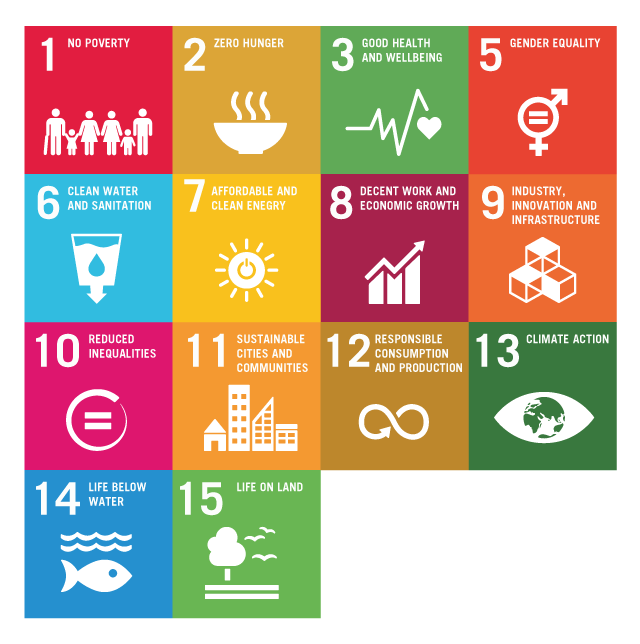
Due to inertia in the climate system, climate change is ‘locked in’ for the next two or three decades (see box below, and also the video interview with Rachel Kyte of the World Bank on the ‘Turn down the heat’ report). Even if greenhouse gas emissions were to stop now, climate change would continue for a further few decades (see graph, below). Thus, significant impacts from climate change are inevitable during the period of the SDGs.
Taking adaptation measures can significantly reduce the risk of climate change impacts on people, assets and livelihoods – sometimes reducing severe risks to only moderate ones, or moderate risks to minor ones. Action on climate change adaptation and action to reduce the risks of climate-related disasters is imperative.
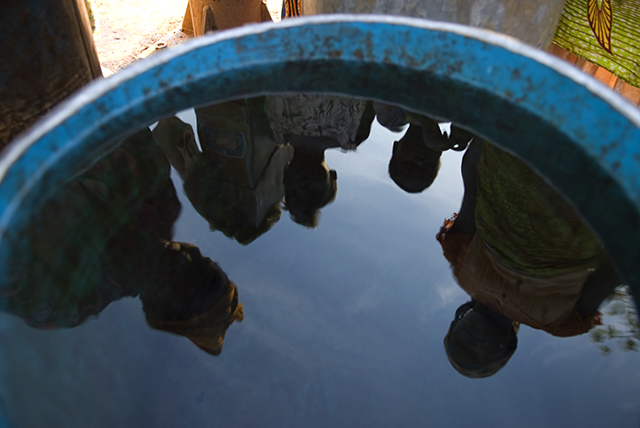
Further change is inevitable in the short term – but the future is in our hands
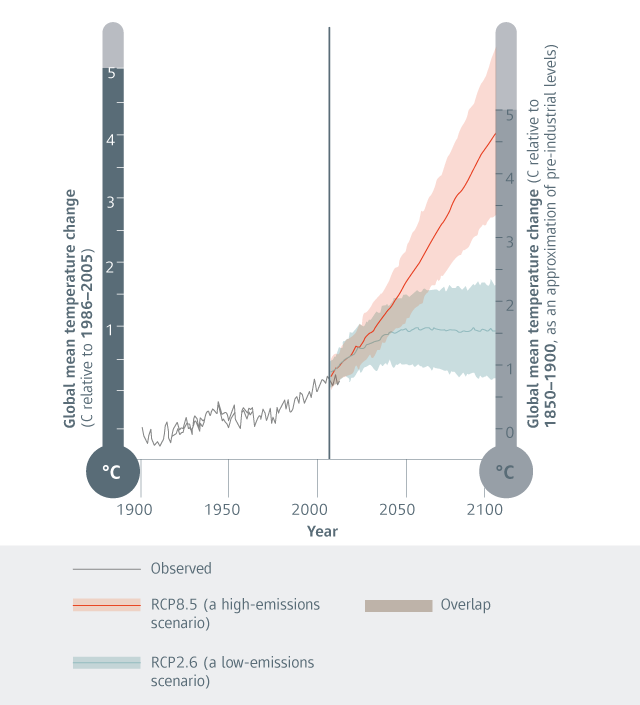
During the short term (to around 2030), there is little difference in the impact of the high-emissions versus the low-emissions scenario on the world’s climate; however, as this graph from the IPCC shows, after around 2030, there is a stark difference between scenarios on the degree of warming. Because there is a delay between when greenhouse gases are emitted or dramatically cut back, and the impact on the climate, very deep cuts in global emissions must begin now.
Global policy frameworks of 2015-16 that address climate change
- Sendai Agreement on Disaster Risk Reduction, 2015
- Addis Action Agenda on Financing Development, 2015
- World Humanitarian Summit, 2015
- Sustainable Development Goals, 2015
- Paris Agreement, 2015
- Kigali Agreement to the Montreal Protocol: Hydrofluorocarbons Phase-down, 2016
- New Urban Agenda, 2016
- International Civil Aviation Organisation agreement, 2016
Global climate change mitigation: there is good and bad news
The mixed news about the Paris Agreement on climate change is that, in climate change mitigation terms, it is a document of inherent contradiction. The foundations of the Agreement were forged through a country-led, ‘bottom-up’ process, instigated and guided elegantly by the 2014-15 Peruvian Presidency of the UNFCCC Conference of the Parties (COP) together with the incoming French COP Presidency (2015-16).
Governments were invited to submit their national climate action commitments to the UNFCCC in advance of the Paris Summit. The emphasis was to be on climate mitigation measures, although the door was left open to declare adaptation activities, too.
This marked a major gearshift in the global politics of climate change, compared to the Kyoto Protocol (2005-2020). The Kyoto Protocol of the UNFCCC separated countries into ‘Annex I’ nations: industrialised countries which were obliged to follow centrally defined emissions reductions targets, and ‘Annex II’ nations, which were not. These agreements neither halted the rise in global greenhouse gas emissions nor addressed the challenges vulnerable countries face in adapting to climate change.
By contrast, under the 2015 Paris Agreement, all nations have agreed to contribute their fair share to the global response to climate change. This theme of action by all nations is backed up by:
- the latest climate science, which emphasises the scale of the challenge;
- the world’s changing demographics, including the rapid rise of a global middle class; and
- the vulnerability of the least developing countries (LDCs), Africa and the small island developing states.
The new agreement must adhere to the core principles of the UNFCCC, including “common but differentiated responsibilities and respective capabilities” and the need for equity, poverty eradication and the survival of nations.
By inviting all Parties to submit a pledge, the Paris process levelled the playing field. For political expediency’s sake, the UNFCCC did not define the precise format that country pledges should take or which methodology to use (e.g. which baseline year to use, whether to set an economy-wide emissions reductions target or declare a set of activities, whether to measure the reduction in emissions per unit of GDP or by sheer volume, and so on).
The openness of this process ensured very high levels of participation: more than 160 Intended Nationally Determined Contributions (INDCs) were filed before the Paris Summit: covering 90% of global emissions and representing over 90% of the global economy. The level playing field also headed off arguments by industrialised countries (the historic polluters) that emergent economies were not doing their share.
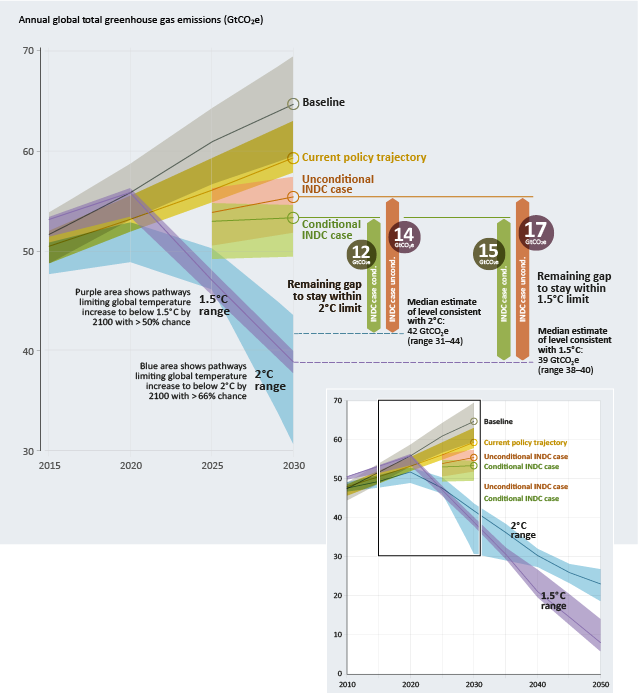
The disadvantage was that the bottom-up process yielded submissions that were in such different forms, that comparing them and aggregating the collective effort is technically difficult. When experts undertook their best effort at aggregation, they concluded that countries’ collective pledges did not add up to anywhere close to the emissions cuts needed to ensure a two-degree world, let alone a 1.5-degree world.
“The world is still heading for a temperature rise of 2.9 to 3.4oC this century, even with Paris pledges,” said the United Nations Emissions Gap report, published in late 2016. The world must cut a further 25% from the predicted 2030 emissions, urged the report. It will take far greater levels of ambition, including by non-state actors, to make up the difference.
Presciently, governments in Paris also made a collective commitment to a ‘ratchet and review’ mechanism for reviewing and increasing the ambition of the national climate pledges. Countries will need to submit increasingly ambitious NDCs to the UNFCCC, at least every five years, without the possibility for ‘backsliding’, and the first global stocktake of progress will take place in 2023.
Any assessment of the global collective effort toward climate mitigation and the Paris process tends, also, to assume that the INDCs – and the Nationally Determined Contributions (NDCs) that they have become – can and will actually be implemented. The NDCs are supposed to be delivered from 2020; a Facilitative Dialogue among Parties to the UNFCCC will take place in 2018 to check on progress toward implementation. CDKN’s international team assisted in the process of INDC preparation in nine countries and tracked efforts in many more: we concluded that in some countries, INDCs were prepared in a highly consultative and participatory way, deepening the chances of successful implementation. In some countries INDCs were dashed off hurriedly in Environment Ministries with little cross-governmental buy-in, let alone broader stakeholder consultation and input. In these cases, there is a far there is a far greater challenge after the Paris Summit, to review and set in motion the wheels of implementation for the NDCs and the economy-wide transformations that they will require. We explore the ‘enabling environment’ for NDC implementation in brief in Chapter 7 of this volume.
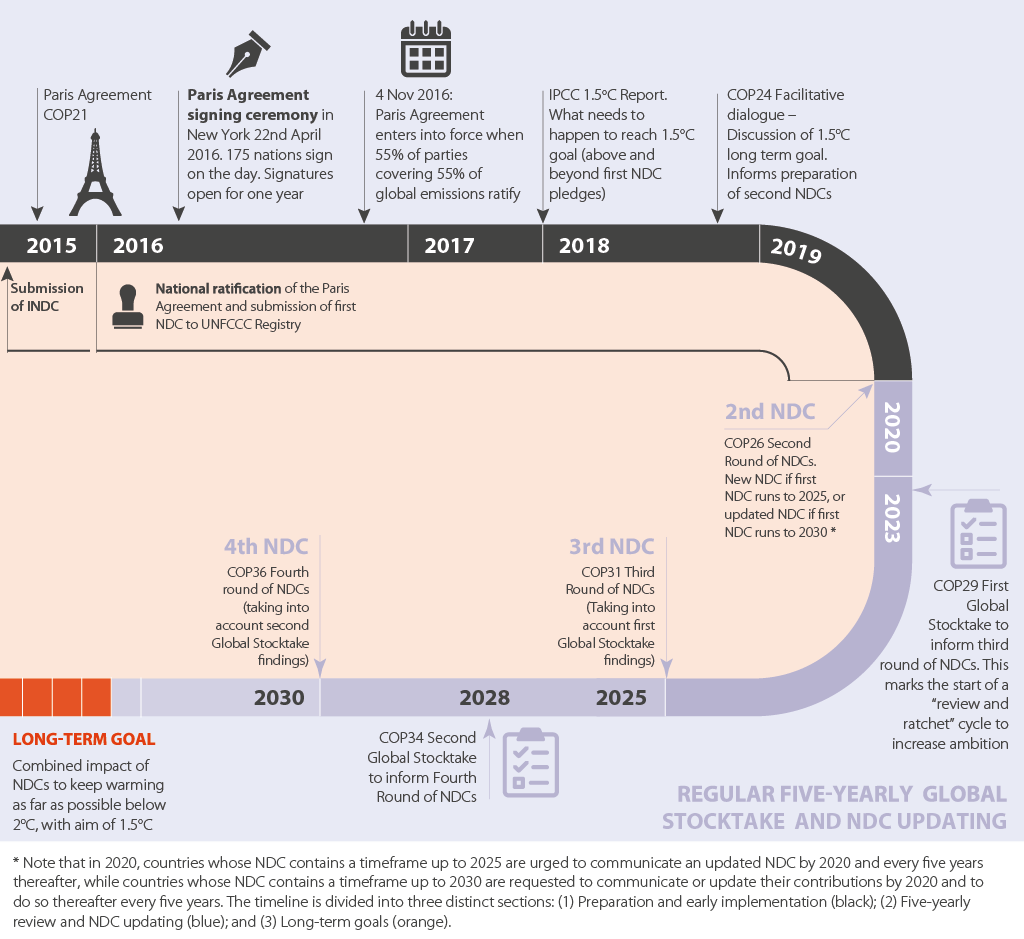
Acting on mitigation today helps millions from future generations to escape poverty
Action on mitigation today will have a direct bearing on worldwide attempts to eradicate poverty over a 15-35 year horizon.
An ODI report by Granoff et al., Zero Poverty, zero emissions: Eradicating extreme poverty in the climate crisis, has concluded, that if climate change goes unchecked, then its impacts could draw up to 720 million people back into extreme poverty during the period 2030-2050. This is roughly the same number of people who escaped from extreme poverty in the last two decades of record development progress.
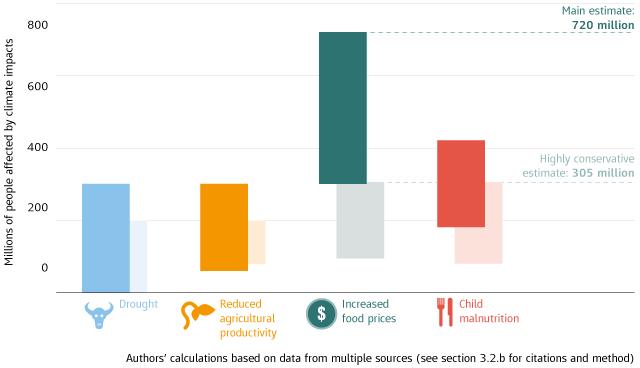
Note: These calculations derive from pathways tracing the impact of climate change on just four factors affecting poverty that have the most robust and easily quantifiable evidence: the productivity of primary sectors; food prices, effects on childhood malnutrition and stunting; and increased droughts. It is likely that the numbers shown would be much higher if other impact pathways were considered, such as sea level rise, urban vulnerability, higher incidence of airborne diseases and secondary impacts on child and female education, fertility and conflict.
Policy-makers must aim for ‘triple wins’ to enable societies to halt climate change, adapt to climate change, and eradicate poverty
We have reviewed the case, above, for why action on climate adaptation and mitigation will be essential to safeguard development gains of the recent past – as well as to ensure safe, secure lives to 2030 and beyond. But there is also a risk that poorly planned climate actions, particularly climate mitigation actions, could fail society if they do not take account of the most vulnerable groups. Climate change already affects the poorest and most excluded in society, including women, children, the elderly, the disabled, ethnic minorities and others (the IPCC’s assessment of vulnerability explores this at length). Efforts to adapt to climate change and build resilience must prioritise resilience for these groups. By the same token, societies must tackle social disadvantage head-on when pursuing mitigation actions. For example, a project which locks up carbon from the atmosphere by planting trees by displacing subsistence farmers, puts the future climate ahead of people’s urgent development needs today.
In Targeting zero zero, Watson, Granoff and McFarland find not only that “Poverty eradication is impossible without a zero net emissions pathway,” but also that “poverty eradication requires equal, moderate and sustained economic growth.” They argue that, “although some mitigation choices can involve costs, sensible low emissions strategies do not make it difficult to expand consumption of the poorest. The major change required is the reduction in the inequality of growth – to help poor people participate in the economy and become the engines of growth themselves.” Their analysis demonstrates why issues of equity must be at the heart of action on climate change.
For all the reasons presented above, approaches are needed that deliver benefits across all three priority areas: climate mitigation, climate adaptation and poverty eradication. CDKN calls this ‘climate compatible development’: development that is defined as “minimising the harm caused by climate impacts, while maximising the many human development opportunities presented by a low-emissions, more resilient, future.”

At a minimum, climate compatible development approaches that are good for one part of the equation should not prove detrimental to another. Climate compatible development requires careful assessment of options and understanding of trade-offs, and engagement and deliberation among stakeholders. It is not an easy way forward, but the only way to create sustainable and enduring development gains for the short- to long-term. This report explores, through CDKN’s programmatic experience, how groups of stakeholders from community to national level have interrogated and navigated options that can achieve ‘triple wins’ for climate adaptation, mitigation and poverty reduction.
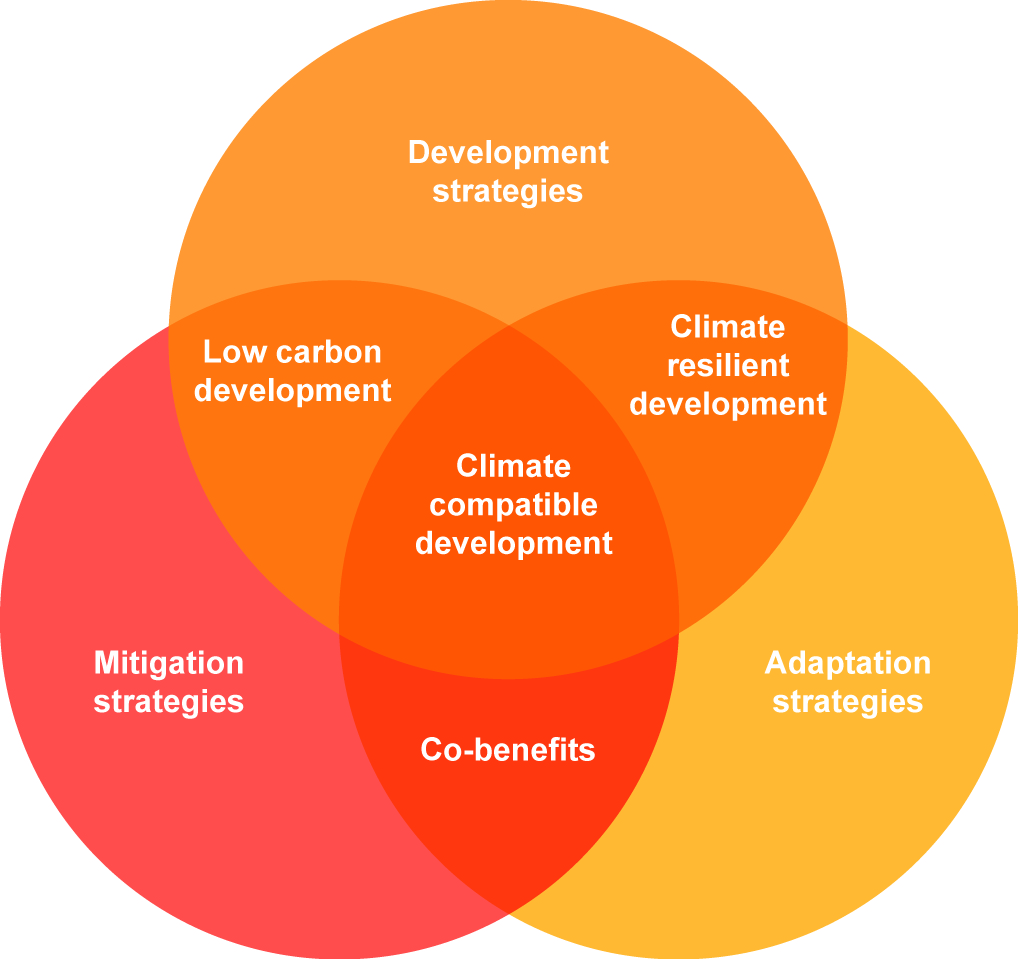
Businesses are showing unprecedented leadership on climate action
One of the Paris Agreement’s greatest legacies will be the strong policy signal that it sent to businesses and investors around the world that the future lies in a low-carbon and eventually a net zero-carbon economy. As well as its ambitious global temperature target, the Agreement aims to make “finance flows consistent with a pathway toward low greenhouse gas emissions and climate resilient development.”
In Paris, governments re-committed themselves to the previous pledge, from the 2009 Copenhagen summit, to mobilise US$100 billion per year to address climate mitigation and adaptation. However, this figure is broadly recognised as representing a ‘token’ portion of what is actually required. Rather, there is a need to mainstream low- to zero-carbon approaches in every aspect of the economy so that the trillions of dollars of business transacted daily will lead to a zero-carbon, climate-resilient society.
A full-scale reorientation of current investment is needed to address the climate crisis: The Global Commission on the Economy and Climate finds, in its flagship report New climate economy (2014) that, without action to mitigate and adapt to climate change, global growth may stall completely: “The next 15 years of investment will determine the world’s climate.”
To achieve this transition requires environmental protection and regeneration on an unprecedented scale. It calls for rapid and profound shifts in production and consumption patterns. UNEP’s The coming financial climate report concludes, “Harnessing the global financial system to deliver climate security, reduces the risks of high-carbon assets. Scaling up capital for the low-carbon transition is possible but will only happen if there is a comprehensive, system-wide approach to financing – including the required US$37 trillion of energy infrastructure – in the next two decades.” Businesses that continue to invest heavily in fossil fuels and do not immediately join the transition pathway to this zero-carbon future will find themselves uncompetitive, and ultimately holding ‘stranded’ fossil fuel-based assets. We have now entered an era when ignoring greenhouse gas emissions is untenable – and when ignoring the impact of future climate change on development plans and infrastructure investments makes no business sense.
At the UNFCCC Conference of Parties one year after Paris, convened at Marrakech, Morocco, the increasing participation of business in the side events and parallel discussions, was notable: here, large and progressive businesses gathered to exchange insights on the opportunities offered by the transition to a low or zero net carbon society. The visionary and active leadership of We Mean Business was evident: this coalition of 496 companies, with more than US$20 trillion under management, gathers voluntary commitments and invites companies and investors to ‘join a low-carbon revolution’.
Just weeks later, the World Economic Forum convened business leaders with government representatives and thought leaders in Davos, Switzerland to pinpoint the key risks to business in the year ahead. The Global risks report 2017 cited the top global risks – in terms of expected impact – for the world in 2017 as: extreme weather events; water crises; major natural disasters and failure of climate change mitigation and adaptation. All of these risks are in some way exacerbated by human-made climatic changes or our failure to act on them. Only a single ‘top five’ risk cited by the World Economic Forum lacks an obvious climate dimension: weapons of mass destruction.
This expert outlook by business, government and non-government leaders emphasises the centrality of climate risks and climate change solutions to the global economy. It underlines that there is no more important task in the months ahead than addressing poverty eradication, human development, economic growth and climate change together.